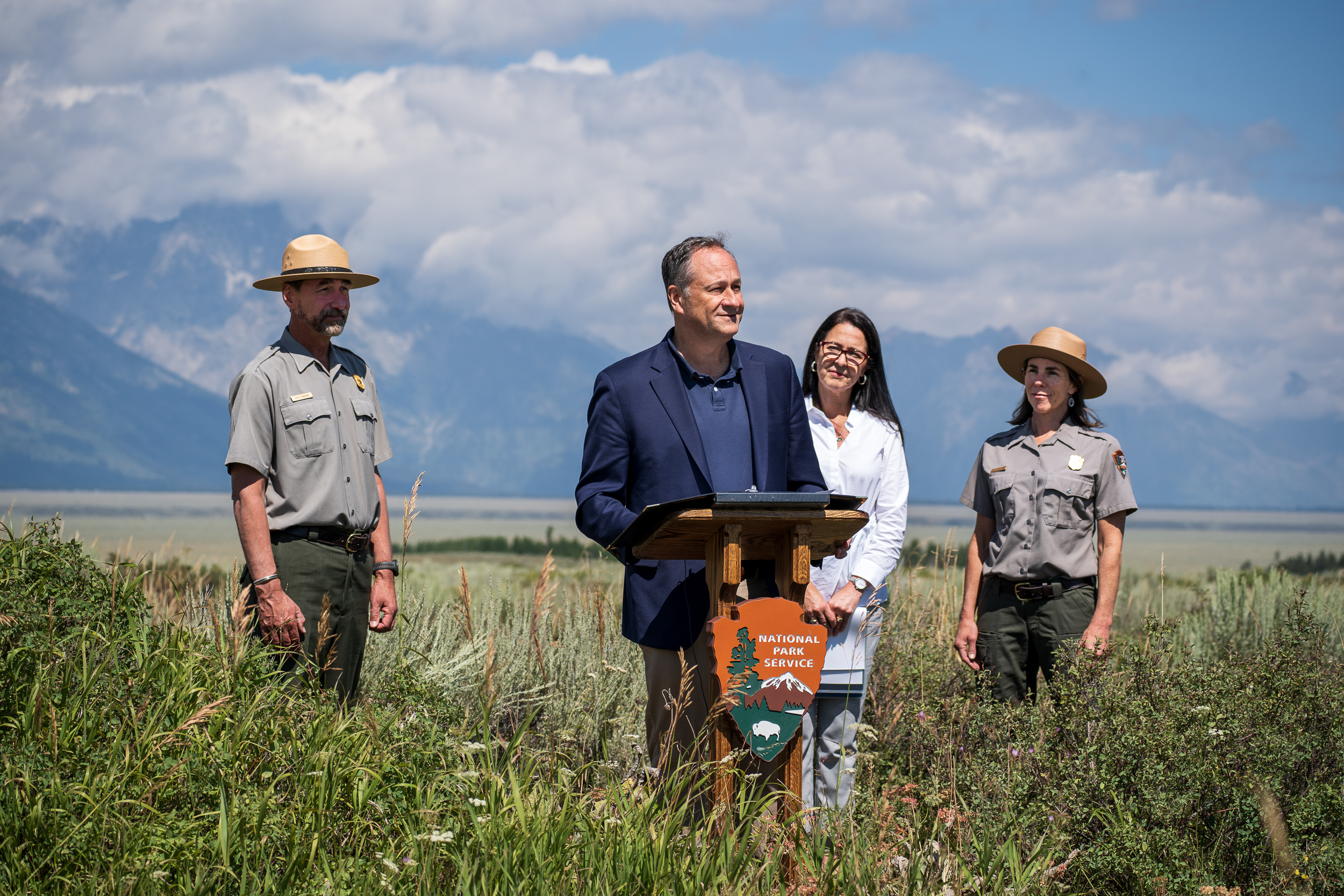In the 1930s, ranchers and right wing radio pundits fought bitterly against expansion of Grand Teton National Park, and ridiculed a wheelchair-bound Franklin D. Roosevelt when FDR used his authority under the Antiquities Act to protect the Jackson Hole valley as a national monument.
The monument would, they said, be a playground for rich folk like the Rockefellers, who had been buying up land with the aim of preserving the valley with a backdrop of the Teton Range. The area was finally added to the national park under President Harry Truman in 1950.
Nowadays, Grand Teton National Park welcomes three million visitors each year. One of them, this week, was America’s first Second Gentleman Douglas Emhoff. The spouse of Vice President Kamala Harris came to announce that $44 million in federal funds will go to National Park Service climate resilient conservation projects, forty-three of them in thirty-nine states.
The 13,775-foot Grand Teton makes a stirring backdrop for conservation announcements. George H.W. Bush, who labeled himself “the environmental president,” used the Tetons as props for signing legislation that strengthened the Clean Air Act. Of course, Bush was also pressing Congress to allow oil drilling in the Arctic Refuge, which it declined to do at the time.
The projects announced by Emhoff are of particular importance to the Northern Rockies. The Park Service will go to work restoring sagebrush to Jackson Hole, in places once cleared by ranchers so they could grow hay.
Park scientists will also tackle protection, preservation and restoration of the threatened, high-elevation Whitebark Pine.
Why should we care about the Whitebark Pine? Because it is an indicator species in a time of climate damage. Fly over the Greater Yellowstone Ecosystem and you will see orange (dying) and gray (dead) pines. Warming temperatures have taken a toll. Whitebark Pines have fallen victim to blister rust caused by a nonnative fungus. Warming temperatures have allowed mountain pine beetles to reproduce in one year rather than multi-year cycles. The beetles kill the oldest, largest trees.
Whitebark Pines hold in place and slow the melt of winter mountain snow packs on steep ridges. Their cones are a food sought after by chickadees, woodpeckers, crossbills, chipmunks, red squirrels and Douglas squirrels. Of greatest consequences, the fatty cones are a vital food source for female grizzly bears.
Grand Teton National Park is home to “399”, the most famous and photographed grizzly bear in the Northern Rockies. She is twenty-seven years old, yet still emerged this spring followed by a cub.
She has given birth to triplets and came out of her den in 2020 followed by four cubs. Park rangers put out cones on roads when they see her.
“Grizzly bear 399 is an ambassador for her species and visitors travel from all over the world to see her and her cubs, so we must continue to implement the best bear safety practices for bears to thrive in the Greater Yellowstone Ecosystem,” in words of Park Superintendent Chip Jenkins, formerly the boss at our North Cascades National Park in Washington State.
”We must act now before it’s too late, too late to preserve this incredible, iconic landscape of Grant Teton,” said Emhoff.
The Jackson Hole valley has seen its share of heroes and villains in America’s land wars. Famed conservationist Mardy Murie lived past the century mark where her home in Moose, Wyoming, now housing a conservation institute. She was a force behind passage of the Wilderness Act and, with husband Olaus, fought for creation of the Arctic Refuge. Murie was awarded the Presidential Medal of Freedom by President Clinton, himself a summer visitor to the Tetons.
Wealthy folk have also settled outside the park in nearby Jackson.
A Wilson, Wyoming, rancher-conservationist named Jake Kittle once took me on a mansion tour, pointing out to me place where a heated porch allowed the owner to entertain even when snow was falling. Said Jake: “The rich don’t come here for the beauty. They come here to be rich.”
Wealthy Republicans, notably Dick Cheney and James Baker, have digs nearby. While Cheney was Vice President, the Park Service would block off public access to a bend of the Snake River so the Veep and buddies could go fly fishing by themselves. Cheney is not popular in the valley.
By contrast, actor Harrison Ford is know for protecting riparian zones on his 800-acre holdings and putting on easements that prevent its future subdivision.
Two prominent Washington elected officials have used Grand Teton National Park to establish that a woman’s place is on top. Future United States Representative Jolene Unsoeld became the first woman to scale the north face of the Grand Teton, together with husband Willi who was an early climbing guide. (He would later climb Masherbrum and the West Ridge of Mount Everest.)
On a fundraising foray to Jackson, where wealthy progressive donors have homes, Senator Maria Cantwell took time out to summit Grand Teton, in the company of Wilderness Society President Doug Walker. The “gentlelady from Washington” has also climbed Mount Rainier and Kilimanjaro, Africa’s highest peak.
Senator Cantwell has gone on to champion conservation, from the barren ground grizzly bears of the Arctic Refuge to the brown bears of Alaska’s Admiralty Island to the salmon runs of Bristol Bar. She helped make possible the projects announced at Grand Teton National Park by Doug Emhoff this week.

